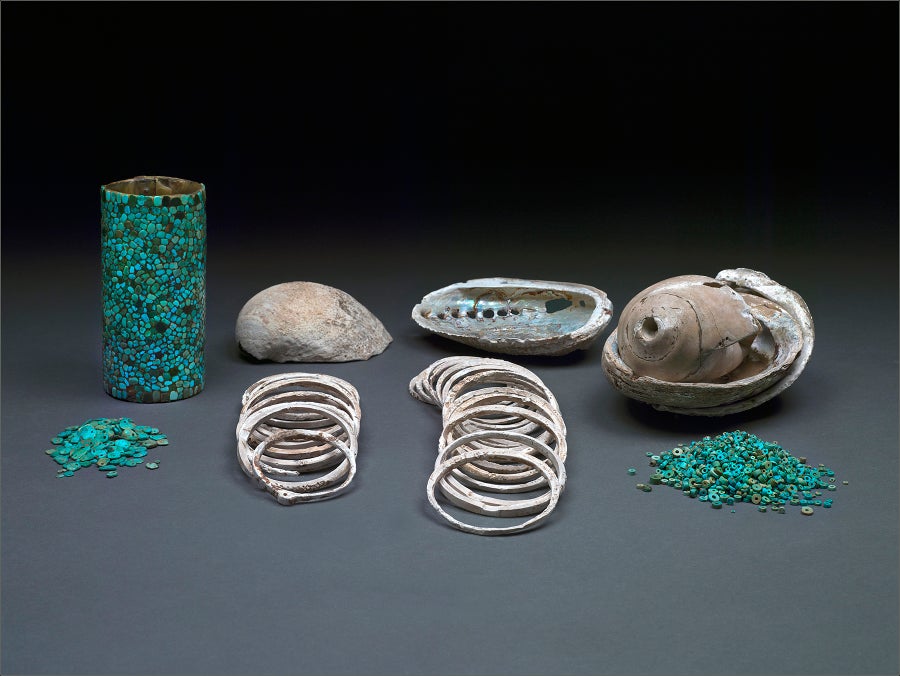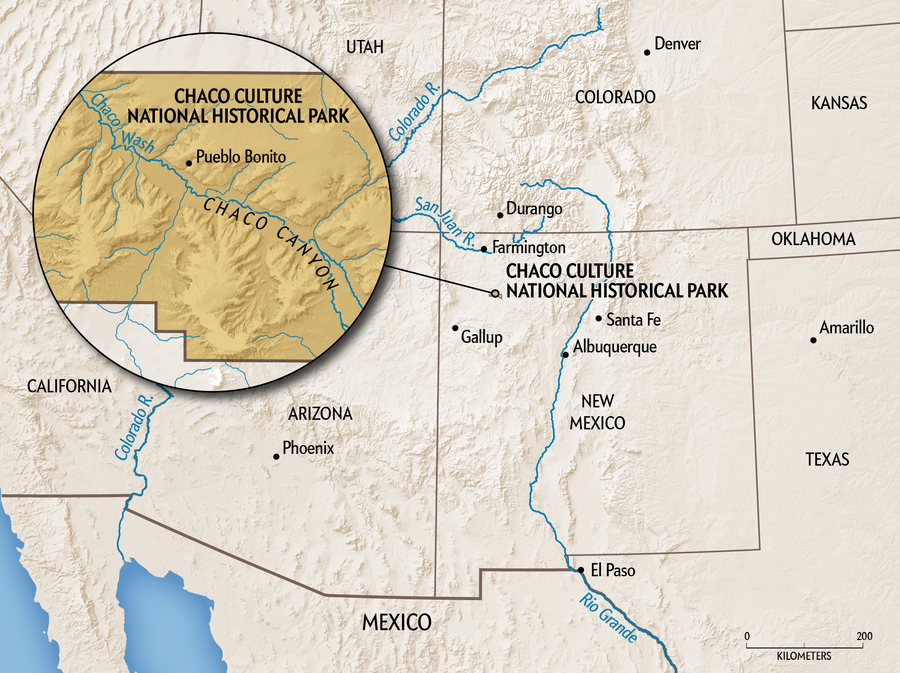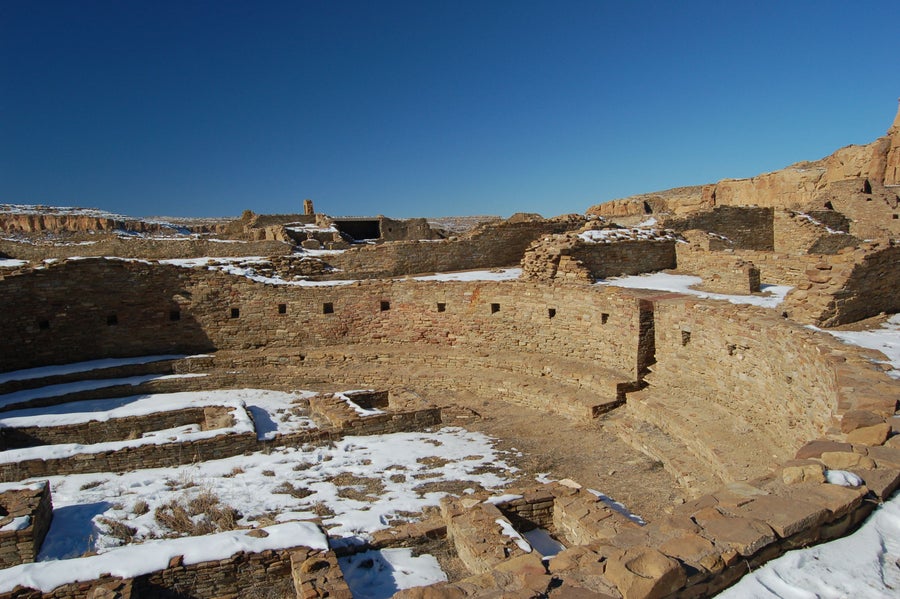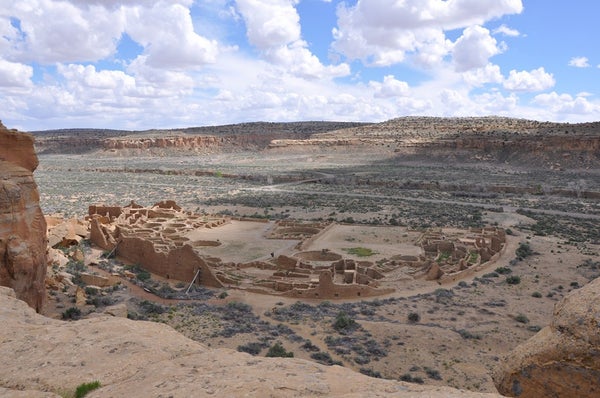In 1896 archaeologists excavating Pueblo Bonito, a 650-room, multistory brick edifice in northwestern New Mexico’s Chaco Canyon, found the remains of 14 people in a burial crypt. Necklaces, bracelets and other jewelry made up of thousands of turquoise and shell beads accompanied the bones. The artifacts signaled that these individuals were elite members of the ancient Chaco society, one of the most important civilizations in the American Southwest.
The excavations at Pueblo Bonito revealed the splendors of Chaco culture, which flourished between about A.D. 800 and 1250. The ancient Chacoans constructed at least a dozen great houses like Pueblo Bonito in Chaco Canyon during its heyday, and dozens of other Chacoan settlements thrived in what is today the Four Corners region where the borders of New Mexico, Colorado, Arizona and Utah meet. Soon after the excavations ended, archaeologists whisked these human remains off to the American Museum of Natural History (AMNH) in New York City, where most of them have resided ever since.
Every so often researchers take the skulls out of their cardboard storage boxes on the museum’s 5th floor and remove the rest of the bones from wooden drawers lining a nearby hallway, laying them out on long tables to study them. They want to know how these people were related to one another and what this elite group might say about how Chaco society was organized. But they have had only limited clues.
On supporting science journalism
If you're enjoying this article, consider supporting our award-winning journalism by subscribing. By purchasing a subscription you are helping to ensure the future of impactful stories about the discoveries and ideas shaping our world today.
Continuing excavations at Chaco over the years have suggested that most people lived in smaller adobe residences surrounding the great houses, leading the majority of archaeologists to conclude Chaco society was hierarchically structured: Elite groups had dominion over cultural, religious and political life and enjoyed special privileges. Now an analysis of DNA from the Pueblo Bonito remains is providing intimate new details about these elite groups and who belonged to them.In a paper published online this week in Nature Communications researchers report the remains belonged to a single maternal line—what the team calls a matrilineal “dynasty”—that lasted for centuries. Other scientists hailed the research as a technical tour de force that helps fulfill the promise of ancient DNA to reveal the lives of ancient peoples. But not everyone agrees with the team’s conclusions, and some experts have criticized their decision not to consult with indigenous groups before going ahead with the research.
Archaeologists Douglas Kennett at The Pennsylvania State University, Stephen Plog of the University of Virginia and their colleagues took a multipronged approach to studying the Pueblo Bonito remains. They first obtained direct radiocarbon dates from 11 of the burials, which ranged from between A.D. 800 and 850 for the earliest to about 1130 for the latest. The dates established that the burials spanned a period of some 330 years.

Credit: Roderick Mickens and Adam Watson
Next the team extracted so-called mitochondrial DNA (mtDNA) from the remains. Mitochondria are tiny subcellular bodies that serve as the power plants for living cells, and their DNA is only inherited via the mother. The researchers were able to sequence an average of 98 percent of the mtDNA from nine individuals spanning the entire 330-year chronological sequence. Remarkably, all nine sequences were identical, meaning that each generation descended from the same original maternal ancestor.
Finally, in an effort to tease out specific family relationships, the team sequenced nuclear DNA—which is inherited from both the mother and father—from six of the burials. These sequences suggested that at least two pairs of individuals were very closely related and probably represented a mother–daughter and grandmother–grandson relationship.
The authors argue this elite group, in which power and influence flowed from mothers to their children, ruled at Pueblo Bonito from the earliest days of its founding around A.D. 800. Plog says the group’s clout probably stemmed from its control of ritual practices at Pueblo Bonito, as evidence by the discovery of objects such as carved wooden flutes and ceremonial staffs in the burial crypt.
The study provides “impressively high resolution” of these matrilineal family ties, says Johannes Krause, a paleogeneticist at Max Planck Institute for the Science of Human History in Germany. Jennifer Raff, an anthropologist at the University of Kansas, agrees. “Paleogenomics approaches like this one can give us insights into the lives of ancient peoples on a scale never before possible.” Neither were involved with the study.
The team’s interpretation of the genetic results makes sense to a number of outside researchers. “This indicates that hereditary leadership was present at the time of Pueblo Bonito’s founding” rather than gradually developing later as some earlier studies had suggested, says Jill Neitzel, an archaeologist at the University of Delaware. “The data show a group of related women, and some men, who can be argued to have been the persistent leaders of Pueblo Bonito for more than 300 years,” says Paul Reed, an archaeologist with Tucson, Ariz.–based Archaeology Southwest. “This research provides some of the most important information about Chaco in many decades,” says Paul Minnis, an anthropologist at the University of Oklahoma. “While most every scholar recognizes that Chaco was centrally organized, the nature of that organization has remained maddeningly opaque.”

Credit: Mapping Specialists
Yet Minnis and others question whether the team is right to call this elite group a dynasty, a term that usually refers to kings and queens who exercise sole rule over vast territories and populations. The Pueblo Bonito group “was clearly an important one,” says Barbara Mills, an anthropologist at the University of Arizona in Tucson. “But was it the only one?” In her view the findings do not prove their power and influence stretched beyond Pueblo Bonito itself, to include all of Chaco Canyon or even the wider “Chaco world.”
Nevertheless, the authors argue their results may resolve another longstanding question. Today’s Pueblo peoples claim, on fairly firm archaeological grounds, to be the direct descendants of the Chacoans; so do the Navajo, on whose land Chaco Canyon now sits. In many modern Pueblo groups, including the Hopi and Zuni of Arizona and New Mexico, respectively, descent and inheritance aredetermined by one’s membership in a maternal clan. (A similar arrangement prevails among Orthodox and some Conservative Jews, for whom Jewish identity depends on having a Jewish mother.) Did they inherit this arrangement from their ancient Chacoan ancestors? Or, as archaeologist John Ware of the Amerind Foundation in Arizona has argued, did early kinship ties in Chaco society give way to rule by so-called “sodalities” based on shared ritual knowledge and practices, such as priests and brotherhoods, in which case some modern Pueblos may have developed their matrilineal organization independently? Kennett, Plog and their colleagues argue their findings support the hypothesis of direct continuity between Chacoan matrilines and those of many Pueblo groups today.
Even as the work lends new support to the affinities between modern indigenous groups and ancient Chacoans, the researchers’ efforts have landed them in a minefield of research ethics. In 1990 Congress passed the Native American Graves Protection and Repatriation Act (NAGPRA), which dictates human remains and other artifacts found on federal or tribal lands must be repatriated to tribal groups if they can successfully establish a direct cultural relationship to them. In some instances such as the famed controversy over the 8,500-year-old Kennewick Man from Washington State, Native Americans and researchers have fought bitterly over who had right of possession.
In the case of the Chaco remains the AMNH decided the NAGPRA did not apply, meaning the researchers were not legally required to get approval from the tribes before conducting research on the remains. In a statement approved by the paper’s 14 authors, the team said that in deciding to not consult the tribes, it relied on the AMNH’s determination that “the cultural complexity of the region made it impossible to establish a clear ancestor–descendant relationship with specific modern communities based on existing data.” The AMNH, in a separate statement, said “the research had considerable scientific merit with little impact on the artifacts and human remains,” adding that it had contacted “potentially affiliated tribes” during the late 1990s but that “none came forward to claim affiliation.”

Credit: Roderick Mickens and Adam Watson
But that decision does not sit well with some critics. “Despite the fact the authors’ work was technically legal, the ethics here are questionable,” says Chaco researcher Ruth Van Dyke of Binghamton University in New York State. “Studies using ancient indigenous DNA should not be done without tribal consultation.”
Rebecca Tsosie, a law professor of Native American descent at the University of Arizona who specializes in tribal and U.S. Indian law, agrees. “I am dismayed that there was not an effort to engage contemporary tribal leaders prior to undertaking and publishing this study,” Tsosie says, adding that the research is a “prime example” of “a study by cultural outsiders to dictate the truth of the history and structure of governance of the cultural insiders, Pueblo Indian nations.”
Team member George Perry, an ancient DNA expert at Penn State, says that whereas the researchers did not formally consult with tribal leaders nor seek their approval to carry out the study beforehand, he is now “working diligently to engage with multiple groups in the Southwest” to “present and discuss the results of the research.” Getting the blessing of indigenous groups may be key to further research because there are other burials at Pueblo Bonito and other Chacoan sites yet to be studied. Moreover, some archaeologists say, some indigenous people might eventually opt to have their own DNA sequenced to see how closely related they might be to ancient Chacoan ancestors—a step taken by at least one Washington State tribal group that turned out to have a close genetic affiliation with Kennewick Man. In that example the scientific evidence backed up tribal arguments for repatriation of what they call “The Ancient One,” and its remains were reinterred by Northwest tribes on February 18 in a secret location.
Some archaeologists are hoping the new study will be just a first step toward a fuller and more detailed understanding of how the ancient Chacoans lived. “How this matriline functioned in the ritual, social and political life of the Chacoans demands more research,” Minnis says. Until other burials can be studied, “we cannot answer the question as to whether the Pueblo Bonito matriline was recognized only by that community or by Chaco as a whole.”
